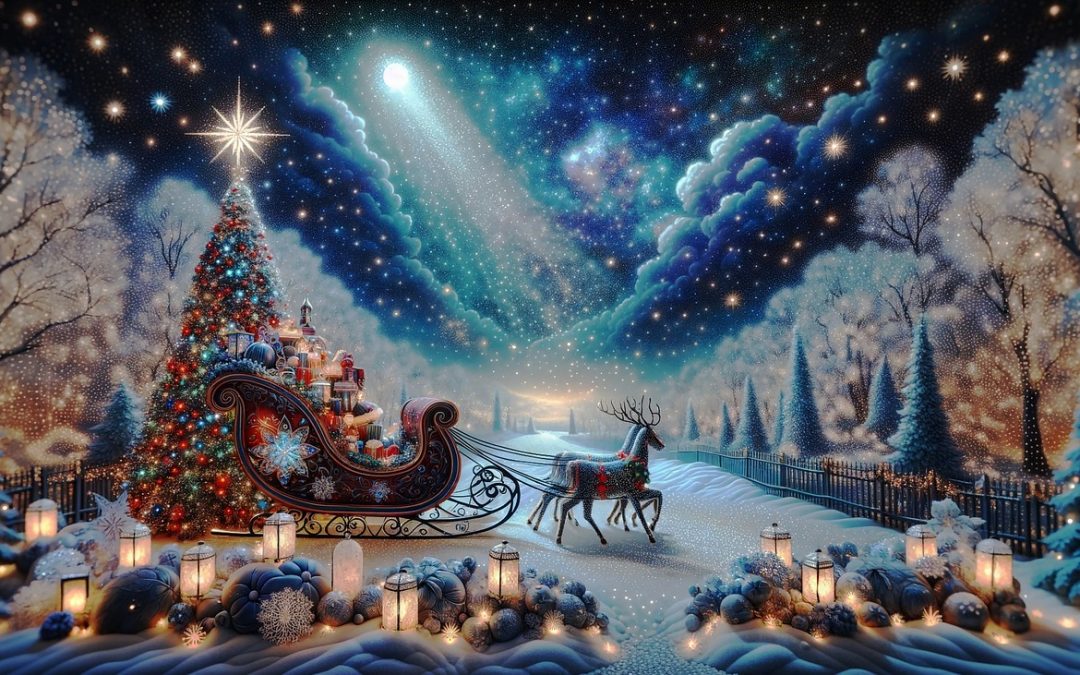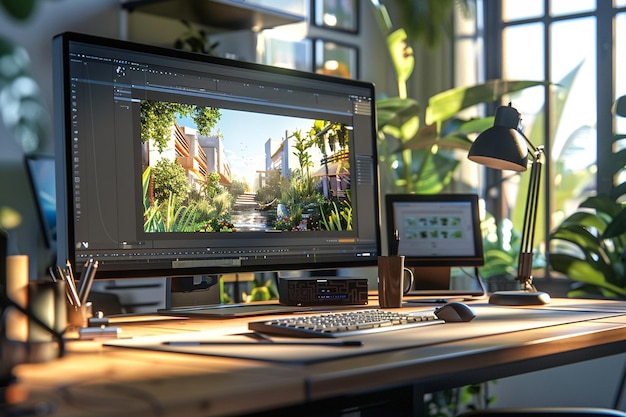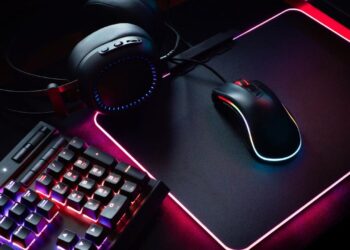Visual Creation

The traditional easel and sculpting tools have found their powerful digital counterparts, enabling artists to paint, draw, and sculpt with new dimensions of control and freedom.
A. Advanced Digital Painting and Drawing Software: Core to modern digital visual artistry are sophisticated digital painting and drawing software suites. Programs like Adobe Photoshop, Procreate, Clip Studio Paint, and Corel Painter offer an unparalleled array of brushes, textures, blending modes, and layering capabilities that mimic and extend traditional media. Artists can experiment endlessly without material waste, undo mistakes instantly, and work in non-destructive ways. Features like perspective grids, symmetry tools, and animation timelines built directly into these instruments allow for precision and complexity previously unimaginable, transforming flat canvases into dynamic, iterative creative spaces.
B. 3D Modeling and Sculpting Software: The transition from physical to digital sculpture is enabled by powerful 3D modeling and sculpting software. Tools like ZBrush, Blender, Autodesk Maya, and Substance Painter allow artists to craft intricate 3D models with immense detail, shaping virtual clay with digital brushes, building complex geometries, and applying realistic textures and materials. These instruments are essential for creating characters, environments, and props for video games, films, animation, and virtual reality. Beyond entertainment, they empower industrial designers, architects, and product developers to visualize and prototype creations with unprecedented accuracy and speed, bringing conceptual ideas into tangible (or virtually tangible) form.
C. Vector Graphics and Illustration Tools: For crisp, scalable, and versatile artwork, vector graphics and illustration tools like Adobe Illustrator and Affinity Designer are indispensable. Unlike raster graphics (pixel-based), vector art is composed of mathematical paths, allowing it to be scaled to any size without loss of quality. These instruments are crucial for logo design, branding, infographics, and intricate illustrations, offering precise control over shapes, lines, and colors. Their ability to generate clean, resolution-independent art makes them essential for web design, print media, and any application requiring adaptable visuals, simplifying complex designs into elegant, scalable forms.
D. Procedural Content Generation (PCG) Tools: Pushing the boundaries of traditional creation, procedural content generation (PCG) tools use algorithms to automatically create vast amounts of digital content, from textures and landscapes to entire cities or complex animations. Software like Houdini allows artists to define rules and parameters, and the software then generates intricate patterns, terrains, or visual effects that would be impossibly time-consuming to create manually. PCG tools are invaluable in game development, film production (for expansive environments), and architectural visualization, empowering artists to build massive, detailed worlds with unprecedented efficiency and emergent complexity.
Sonic Landscapes
The world of music and sound design has been revolutionized by digital instruments that provide infinite sonic palettes, precision editing, and powerful production capabilities.
A. Digital Audio Workstations (DAWs): At the core of digital music production are Digital Audio Workstations (DAWs) such as Ableton Live, Logic Pro X, Pro Tools, and FL Studio. These comprehensive software environments allow musicians, producers, and sound engineers to compose, record, edit, mix, and master audio. They integrate virtual instruments, effects plugins, and powerful editing tools, turning a computer into a complete recording studio. DAWs democratize music creation, enabling artists to produce professional-quality tracks from their bedrooms, breaking down barriers to entry in the music industry and fostering diverse new genres.
B. Virtual Instruments and Synthesizers: The variety of sounds available to digital artists is virtually limitless, thanks to virtual instruments and synthesizers. These software-based instruments emulate everything from classic grand pianos and orchestral ensembles to futuristic electronic synthesizers and drum machines. They offer deep customization, allowing creators to sculpt unique sounds from scratch or manipulate existing samples. This eliminates the need for expensive physical instruments and provides unparalleled sonic flexibility, enabling musicians to explore new timbres and textures previously unattainable, transforming laptops into powerful sound design labs.
C. Audio Effects Plugins and Mixing/Mastering Tools: To shape and polish digital audio, audio effects plugins are essential. These include virtual reverbs, delays, equalizers, compressors, and distortion units that can dramatically alter the sound of instruments or vocals. Powerful mixing and mastering tools within DAWs or as standalone applications provide precise control over volume, panning, dynamics, and stereo imaging, allowing engineers to balance individual elements and prepare tracks for commercial release. These digital instruments ensure that the final audio product is polished, impactful, and ready for distribution across any platform.
D. Generative Music AI: An emerging frontier is generative music AI, algorithms capable of composing original music based on learned patterns, specific styles, or user-defined parameters. Tools like Amper Music, AIVA, and Google’s Magenta are exploring this space, allowing creators to rapidly generate melodies, harmonies, and rhythms. While not fully replacing human composers, these AI tools can serve as creative collaborators, assisting with idea generation, background music for content, or even exploring entirely new musical structures, blurring the lines between computational logic and artistic intuition.
Interactive Narratives

Digital artistry extends beyond static images or linear audio to create immersive and interactive narratives that redefine storytelling and user engagement.
A. Game Development Engines: The heart of interactive digital artistry lies in game development engines like Unity and Unreal Engine. These robust platforms provide comprehensive tools for designing, developing, and deploying video games and interactive simulations across various platforms. They include rendering engines for graphics, physics engines for realistic interactions, animation systems, and visual scripting tools, empowering designers, programmers, and artists to collaborate on complex interactive experiences. These engines have democratized game creation, allowing independent developers to compete with large studios and foster a vibrant ecosystem of digital storytellers.
B. Virtual Reality (VR) and Augmented Reality (AR) Development Kits: Creating immersive digital worlds requires specialized VR and AR development kits. These include software development kits (SDKs) for platforms like Meta Quest, SteamVR, and Apple Vision Pro, along with hardware like motion controllers and haptic devices. Artists use these instruments to build interactive 3D environments, design spatial interfaces, and craft compelling narratives that leverage the unique capabilities of virtual and augmented realities. From virtual art galleries to interactive educational experiences, these tools are redefining how we consume and engage with content, placing the audience directly within the artistic creation.
C. Interactive Storytelling and Twine Engines: Beyond traditional linear narratives, interactive storytelling tools allow creators to build branching narratives where audience choices influence the plot. Platforms like Twine enable writers and designers to create text-based adventure games, interactive fiction, and choose-your-own-adventure stories with relative ease. These instruments foster a unique form of digital artistry where narrative structure becomes a dynamic, non-linear canvas, inviting readers to become active participants in the unfolding story, blurring the lines between author and audience.
D. WebXR and Browser-Based Interactive Experiences: The web itself is becoming a platform for immersive digital artistry through WebXR. This set of technologies allows VR and AR experiences to be delivered directly through a web browser, eliminating the need for app installations. Artists are leveraging JavaScript frameworks and WebGL to create interactive 3D environments, virtual tours, and augmented reality filters directly accessible via a URL. This democratizes access to immersive content, making it easier for artists to share their interactive creations with a global audience without proprietary software or dedicated hardware.
Beyond Traditional Disciplines
Digital artistry is continuously expanding into previously distinct disciplines, creating hybrid art forms and pushing the boundaries of what is considered art.
A. Generative Art and Algorithmic Design Tools: Generative art involves using algorithms and code to create visual art. Artists define parameters and rules, and the computer then generates unique, often intricate, and endlessly variable patterns, images, or animations. Tools like Processing, OpenFrameworks, and various Python libraries enable coders and visual artists to explore mathematical beauty, emergent complexity, and randomness as core artistic elements. This moves artistry from direct hand-creation to designing systems that create art, blurring the line between artist and programmer.
B. AI Art Generators (Text-to-Image Models): A recent and revolutionary development are AI art generators that create images from natural language text prompts (e.g., Midjourney, DALL-E, Stable Diffusion). These instruments, powered by massive deep learning models, allow users to “describe” their desired image, and the AI generates stunning, often photorealistic or stylistically unique artwork in seconds. While raising questions about authorship and originality, these tools democratize image creation, enabling anyone to produce high-quality visuals without traditional artistic skills, serving as powerful idea generators and rapid prototyping tools for visual concepts.
C. Virtual Production and Real-time Rendering Tools: In film and television, virtual production is a revolutionary approach that leverages video game engines and real-time rendering to allow filmmakers to shoot scenes against digital backgrounds that react instantly to camera movement. Tools like Unreal Engine’s nDisplay and LED volumes replace traditional green screens, providing actors with immersive environments and directors with immediate feedback on visual effects. This real-time interaction transforms the filmmaking process, integrating visual effects seamlessly into live action and offering unprecedented creative control on set.
D. Bio-Art and Data Visualization Instruments: Digital artistry is even intersecting with biology and data science. Bio-art utilizes living organisms, biological processes, or scientific data as artistic mediums, often enhanced by digital tools for visualization or manipulation. Data visualization instruments transform complex datasets into compelling visual narratives, using algorithms and graphic design principles to make abstract information understandable and aesthetically engaging. These tools empower artists to explore scientific concepts, environmental data, or social trends through a creative lens, giving form to the invisible forces shaping our world.
Democratization, Collaboration, and Challenges
The emergence of these new digital instruments brings with it profound implications for artists, industries, and society at large.
A. Democratization of Art Creation: Many of these digital instruments, especially software and open-source platforms, are increasingly accessible and affordable. This democratizes art creation, allowing individuals from diverse backgrounds to explore various artistic disciplines without the high costs associated with traditional materials, studios, or specialized equipment. It fosters a more inclusive artistic landscape, encouraging experimentation and diverse voices.
B. Enhanced Collaboration and Remote Production: Digital tools inherently facilitate enhanced collaboration, allowing artists, designers, and producers to work together seamlessly across geographical distances. Cloud-based platforms, version control systems, and real-time sharing capabilities enable teams to co-create, review, and iterate on projects efficiently. This has revolutionized global production pipelines in film, gaming, and design, breaking down geographical barriers to creative teamwork.
C. New Artistic Mediums and Hybrid Forms: The blending of traditional and digital techniques, along with the unique capabilities of digital tools, has given rise to entirely new artistic mediums and hybrid art forms. From augmented reality sculptures that only exist in specific physical spaces to interactive installations controlled by audience participation, digital instruments are pushing the boundaries of what art can be, fostering innovative cross-disciplinary practices and challenging conventional definitions.
D. Intellectual Property and Copyright Challenges: The ease of digital reproduction, manipulation, and the rise of generative AI raise complex intellectual property and copyright challenges. Who owns the art created by an AI? How can artists protect their digital creations from unauthorized use or modification? Existing legal frameworks are struggling to keep pace, necessitating new approaches to copyright, licensing, and attribution in the digital age.
E. The Role of the Artist and Skill Evolution: The proliferation of powerful digital instruments necessitates an evolution in the role of the artist. While traditional skills remain valuable, new competencies in software proficiency, algorithmic thinking, data management, and understanding digital workflows are increasingly important. The debate around whether AI generators diminish the value of human artistry highlights the ongoing adaptation required, shifting the artist’s role towards curator, prompt engineer, or conceptual director, even as traditional craft remains vital.
F. Digital Preservation and Longevity of Art: Unlike physical art, digital art faces unique challenges in digital preservation and longevity. File formats can become obsolete, software can cease to be supported, and storage media can degrade. Ensuring that digital artworks remain accessible and viewable across future technologies requires proactive strategies for archiving, emulation, and migration, challenging institutions and artists to think about the long-term viability of their creations.
Conclusion
In conclusion, the emergence of digital artistry’s new instruments is not merely a technological shift; it’s a cultural revolution that is fundamentally changing everything about how art is conceived, created, distributed, and experienced. From hyper-realistic 3D models and immersive VR narratives to AI-generated compositions and blockchain-verified digital collectibles, these tools empower creators with unprecedented expressive capabilities. While navigating the complex ethical, legal, and societal implications will be an ongoing journey, the boundless potential for innovation, democratization, and the exploration of new aesthetic frontiers ushered in by these digital wonders promises a vibrant and ever-evolving future for human creativity. The digital canvas is vast, and artists are just beginning to explore its infinite possibilities.







